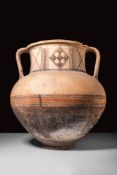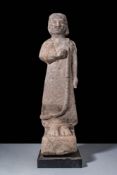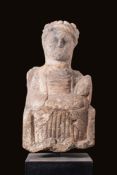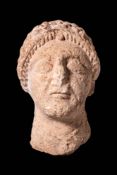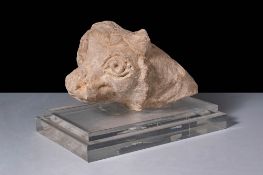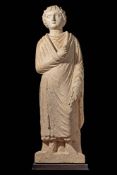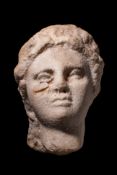Verfeinern Sie Ihre Suche
Auktionshaus-Kategorie
- Achaemenid (1)
- African Art (1)
- Amlash (1)
- Anatolian (1)
- Anglo-Saxon (2)
- Assyro-babylonian (1)
- Bactrian (2)
- Bronze Age (5)
- Byzantine (33)
- Canaanite (1)
- Canosan (1)
- Celtic (3)
- Crusaders (1)
- Cypriot (5)
- Daunian (4)
- Egyptian (150)
- Etruscan (4)
- Gandharan (4)
- Graeco-Roman (1)
- Greek (48)
- Hellenistic (13)
- Inuit (1)
- Iron Age (2)
- Merovingian (4)
- Mesopotamian (5)
- Minerals (5)
- Minoan (1)
- Mittelalterlich (26)
- Moche (1)
- Mughal (1)
- Neo-assyrian (4)
- Neoclassical (1)
- Palmyrian (1)
- Phoenician (9)
- Post-medieval (1)
- Renaissance (2)
- Roman (93)
- Romano-Egyptian (10)
- Sasanian (5)
- Scythian (4)
- Stamp seals (6)
- Syro-Hittite (1)
- Umayyad (3)
- Viking (12)
- Western Asiatic (7)
- 中文 (1)
Kategorie
- Schmuck (157)
- Präparate & Naturkundliches (86)
- Griechische, Römische, Ägyptische & andere Antiquitäten (64)
- Glas & Kristall (31)
- Varia (24)
- Skulpturen (23)
- Waffen, Rüstungen & Militaria (19)
- Großuhren (16)
- Münzen (12)
- Bücher, Manuskripte & Schriften (9)
- Metalle (9)
- Historische Baustoffe & Elemente (8)
- Keramik, Fayencen (8)
- Textilien (7)
- Spielzeug, Modelle & Puppen (5)
- China (4)
- Porzellan (4)
- Vintage Fashion (3)
- Silber & Versilbertes (2)
- Werkzeug (2)
- Wissenschaftliche Instrumente (2)
- Barometer (1)
- Ethnographie & Stammeskunst (1)
- Gemälde & Mischtechniken (1)
- Islam (1)
- Küchenutensilien (1)
- Sport Memorabilia & Equipment (1)
Künstler / Marke
- Liste
- Galerie
-
501 Los(e)/Seite
Ca. 750 - 600 BC. A large example of a wheel-thrown pottery amphora with a flat, circular base, an inverted piriform body with a rounded shoulder,...
Ca. 600 - 500 BC. A standing figure of a votary carved from limestone, depicted with a broad face and short hair. He wears a close-fitting garmen...
Ca. 460 - 450 BC.A stone statuette of the crowned goddess Astarte, dressed in a peplos and kalathos, seated on a throne holding a baby at her ches...
CYPRIOT STONE HEAD OF A GOD
Ca. 450 - 380 BC. A limestone head of a male sensitively carved with a sweet visage with generously lidded eyes, a naturalistic nose, and thin lip...
Ca. 1500 - 1300 BC. A sculpted limestone head with large almond-shaped eyes, a broad snout with defined nostrils, and short projecting horns. Mou...
Ca. 400 - 300 BC. A rare askos with a globular body, cylindrical neck, and a pair of horizontal handles at the midsection. Two vertical spouts ri...
Ca. 550 BC. A terracotta funnel krater with a globular body, flaring rim, and a pair of vertical strap handles rising above the rim, interspersed...
LARGE DAUNIAN BICHROME JUG
Ca. 550 BC. A large terracotta jug with a globular body, wide flaring mouth, and a single broad strap handle extending from the rim to the should...
Ca. 650 - 600 BC. A terracotta amphora with a large ovoid body that gently tapers towards a thick ring base. The short neck transitions into a sl...
Ca. 600 - 500 BC. An oval banded agate intaglio engraved with the figure of a striding lion facing right, with incised detailing along the mane, ...
Ca. 500 BC. A bronze strainer with a hemispherical bowl perforated concentrically at the base. The flat handle is cast in one with the bowl, term...
Ca. 375 - 350 BC. A large krater with an inverted bell-shaped body that tapers towards a thick, disc-shaped base. Two loop handles extend from the...
Ca. 360 - 350 BC. A red-figure bell-krater attributed to the Black Thyrsus Painter, constructed with a broad bell-shaped body, flaring rim, and di...
APULIAN BELL KRATER
Ca. 400 - 300 BC. A red-figure krater with a flaring lip, concave neck, and deep bell-shaped body tapering into a narrow footed base. The handles ...
ATTIC KYLIX WITH PALMETTES
Ca. 520 - 500 BC. A black-figured kylix with a shallow cup tapering towards the footed base. The vessel is equipped with slightly upturned handles...
Ca. 350 - 300 BC. A black-glazed terracotta pelike with a pear-shaped body on a footed base, a tall neck with everted rim, and twin vertical strap...
Ca. 450 BC. A wheel-thrown terracotta skyphos with horizontal handles and a ring base, decorated in the red-figure technique. The body is decorate...
Ca. 1200 - 800 BC. A cast bronze spearhead with an elongated, triangular blade with a prominent midrib. It terminates in a crescent-shaped openwo...
Ca. 400 BC. A silver circular phalera with central gorgoneion in repoussé, framed by six hemispherical rivets evenly spaced around the upper sect...
RARE GREEK SILVER JAR
Ca. 500 BC. A jar with an ovoid body with a pointed base. The fluted body is decorated with protruding knots under the neck, which is embellished ...
Ca. 300 - 100 BC. A large pyramidal semi-precious stone pendant set in a gold mount, adorned with gold pellets arranged in vertical lines. The gol...
Ca. 1st millennium BC. A necklace composed of striated agate and carnelian beads, alternating with openwork gold beads, creates a colour balance t...
Ca. 300 - 200 BC. An amphoriskos made using the core-forming technique, with a dark body tapering to a pointed base and a short cylindrical neck ...
Ca. 450 BC. A terracotta skyphos with a deep, slightly flaring body, a flat base, and two horizontally extending handles positioned at the upper s...
Ca. 350 - 300 BC. A shallow red-figure terracotta plate on a stepped foot, with broad offset rim, the tondo decorated with the female head in the ...
Ca. 500 BC. A bronze double-headed hammer with an S-shaped form, each end terminating in an opposite beast-shaped head, one facing upward and the...
Ca. 500 - 300 BC. A bronze appliqué in the shape of a stylised griffon, featuring an elongated body with openwork elements extending along the ba...
IRON AGE LONG SWORD
Ca. 500 BC. A long iron sword with a narrow blade of near-parallel edges, tapering to a sharply defined point. The base of the blade leads into a...
CELTIC SILVER RITUAL MASK
Ca. 100 - 1 BC. A silver mask of elongated form with incised and repoussé facial features, including a pronounced linear nasal ridge, a rectangul...
Ca. AD 1 - 100. A circular bronze phalera depicting the head of Medusa in high relief. The face is rounded with full cheeks, a slightly upturned ...
Ca. 500 BC. A bronze helmet of Corinthian type, hammered from a single sheet to form a seamless, domed structure with a contoured profile. The fr...
CHALCIDIAN BRONZE HELMET
Ca. 500 BC. A bronze helmet of Chalcidian type, with a high crown and a reinforced horizontal ridge running around the circumference. A pronounce...
Ca. 400 - 300 BC. A bronze helmet of the Montefortino type, featuring a domed form that closely resembles a jockey cap. The helmet consists of a ...
CHALCIDIAN BRONZE HELMET
Ca. 500 BC. A bronze helmet of Chalcidian type, with a high crown and a reinforced horizontal ridge running around the circumference. A pronounce...
Ca. AD 100 - 200. A marble head of a noblewoman, inspired by a Greek bronze statue, with idealised facial features. The smooth forehead transitio...
Julio-Claudian Period, Ca. 27 BC - 68 AD. A marble head of a youthful male with idealised features. Notice that the sculptor presents this individ...
Ca. AD 68 - 112. A marble head of Salonia Matidia, niece of Emperor Trajan and mother-in-law of Emperor Hadrian, depicted with finely carved feat...
Roman Period, Ca. 200 BC - AD 100. A limestone figure of a youth standing on an integral rectangular base, clad in a long himation falling in cas...
Ca. AD 1780 - 1850. A marble bust of a Roman emperor, wearing a tunic and cuirass with lappets covering the shoulder. Draped over the cuirass is ...
Ca. AD 1 - 50 . A column capital carved in Proconnesian marble. The lower register is adorned with alternating open and closed palmettes emerging...
Ca. 200 AD. A finely carved in extremely high relief 'virtually in the round' section of a marble sarcophagus depicting the god Eros (Roman Cupid)...
ROMAN MARBLE RELIEF WITH SOLDIER
Ca. AD 100. A beautiful relief carved marble panel featuring a helmeted soldier and robed man, both in profile with their heads to the right. The ...
Ca. 400 - 200 BC. A carved quartzite head of a female, with a rounded face, prominent cheekbones, and a slightly parted mouth. The eyes are almon...
Ca. 300 - 100 BC. A marble head of Aphrodite with a softly rounded face. Her hair is styled in thick, wavy locks, and drawn back into a low chigno...
Ca. AD 180 - 220. A silver circular plaque with a relief portrait of a female. The portrait shows her with a slight tilt of the head and a downcas...
Ca. AD 1 - 300. A marble funerary stele carved with a standing figure of a Roman soldier in a short tunic. The reverse is worked flat, indicating...
Ca. 500 - 400 BC. A silver bowl with a broad, outward-flaring rim. The interior features a raised central boss, a mesomphalos, surrounded by eigh...
EASTERN GREEK SILVER PHIALE
Ca. 500 BC. A silver phiale with a shallow, wide body and a slightly convex base. The gently flaring rim extends outward, forming a broad lip with...
EASTERN GREEK SILVER PHIALE
Ca. 500 - 300 BC. A silver phiale with a shallow, wide body and a slightly convex base. The gently flaring rim extends outward, forming a broad li...
Ca. 500 BC. A silver oinochoe with a pear-shaped body that tapers towards a narrow neck and expands into a wide, flaring rim. The vessel stands on...
Ca. 300 - 100 BC. A shallow silver bowl with wide, gently sloping sides and a rounded base. The interior features concentric bands of parcel-gilt ...
ROMAN MILLEFIORI GLASS BOWL
Ca. AD 1 - 300. A millefiori glass bowl with a shallow, wide body and an everted rim. The surface displays vibrant polychromy, composed of fused ...
Ca. 300 - 250 BC. A gold ring with an oval bezel engraved with a profile bust of a noblewoman facing left. She is shown with a coiffure of tightl...
Ca. AD 100 - 300. A red intaglio engraved with the profile bust of a female deity facing left, wearing a wreath on stylised hair arranged in para...
Ca. AD 1 - 200. An oval red carnelian intaglio engraved with a gryllos composed of a bird-like figure with an elongated neck and head held high, ...
Ca. AD 1 - 200. An amethyst intaglio depicting the profile bust of a nobleman facing left, his head slightly thrust forward. The face is elongate...
Ca. 100 BC - AD 100. A matched pair of gold earrings, each with a discoid upper element inset with white inlay, framed by a twisted wire border. T...
ROMAN GOLD RING WITH ANTELOPE
Ca. 100 BC - AD 100. A gold ring with an oval bezel engraved with a depiction of a grazing antelope facing left. The animal is shown with defined...
Ca. AD 100 - 300. A gold ring with a D-section round hoop featuring a central ridge enlarged on the flat shoulders to form a round bezel, whichj s...
Ca. AD 100 - 300. A garnet intaglio engraved with a figure of Gryllos shown in profile, combining a human head with the body of a cockerel. The i...
-
501 Los(e)/Seite


